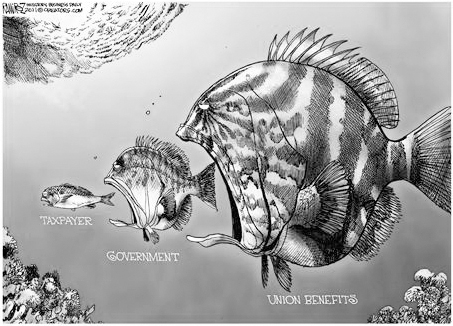Big Labor's War on the Private Sector in Ohio and across the USA
Stan Greer of the National Right to Work Committee comments on big labor's ongoing efforts to have taxpayers finance their growing payroll costs in Ohio:
Over the past four decades, the share of Ohio private-sector employees' pay that is consumed by the Buckeye state's heavily unionized state and local government workforce payroll costs has soared dramatically.
U.S. Commerce Department's Bureau of Economic Analysis data show Ohio's state and local government employee compensation (including wages, salaries, benefits and bonuses) amounted to 11.2 percent of all compensation for private-sector employees in 1970. By 1990, the number had soared to 14.6 percent. Last year alone, total state and local compensation rose 7.7 percent, to $29.4 billion — or 17.3 percent of total compensation for private-sector employees.
Ohioans' government employee spending burden grew vastly over the past 40 years even as the state's constituencies for several key services furnished by state and local employees shrank as a share of the total population. For example, in 1970, 26.4 percent of Ohio residents were K-12 school-aged (5-17 years-old). By 2010, just 17.4 percent of Ohio residents were in the same age bracket.
As of 2010, 46.2 percent of the Buckeye state's public employees were laboring under a contract negotiated by union officials wielding monopoly bargaining power. By comparison, just 9 percent of Ohio's private-sector employees were unionized. Ohio is far from the only state in which business employees and employers are increasingly overburdened by a Big Labor-dominated government sector.
But Ohio's private sector is having an especially hard time. While private employer expenditures for employee compensation increased by an inflation-adjusted 4.3 percent from 2000-2010 nationwide, Ohio businesses spent 6.6 percent less on employee compensation in 2010 than they had in 2000. Ohio is one of just five states with negative private-sector compensation growth over the past decade.
All five of these economic laggards have something in common: They lack a right-to-work law protecting employees' freedom to refuse to join or pay dues or fees to an unwanted union, without being fired as a consequence. In fact, 13 of the 14 states with the lowest 2000-2010 private-sector compensation growth don't have right-to-work laws.
In the 22 states that have right-to-work laws in effect, real private employee compensation over the same period grew by an aggregate 11.3 percent — two-and-a-half times as much as the national average. Meanwhile, private-sector employees in 20 of the 22 right-to-work states experienced compensation growth above the national average.
The best news Ohio business employees and employers have had in many years was the passage into law this spring of Senate Bill 5, a government reform package that includes provisions protecting the right to work for all state and local public employees. It also reduces the scope of government union officials' monopoly-bargaining privileges in several other ways.
While a full-fledged right-to-work law would do much more to get Ohio back on track, Senate Bill 5 marks a significant step in the right direction. Nearly half of the forced dues-paying employees in Ohio are government workers. A huge chunk of the loot Big Labor rakes in from such workers goes into electioneering and lobbying efforts in support of union officials' tax-spend-and-regulate agenda — greatly impeding private-sector job and income growth.
Over the course of the next few years, Senate Bill 5 can begin undoing the damage Big Labor has wrought on Ohio over the years — if union officials' ongoing, multimillion-dollar, forced dues-fueled campaign to overturn it is first thwarted.





